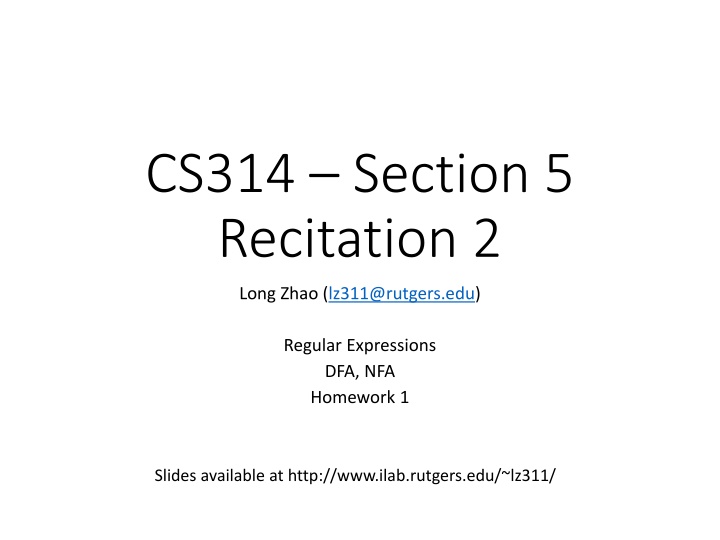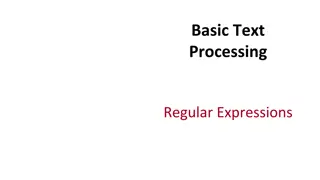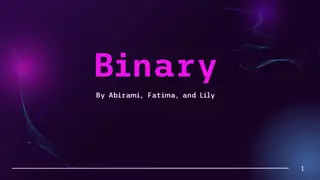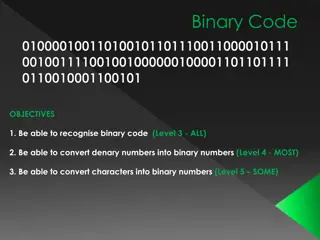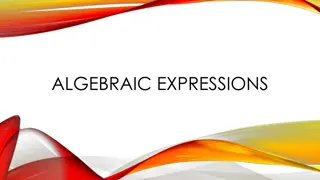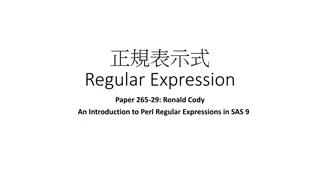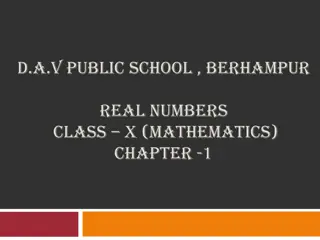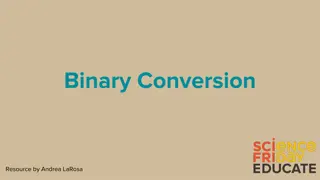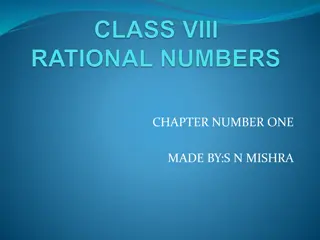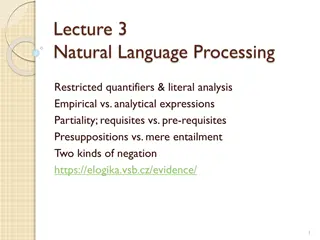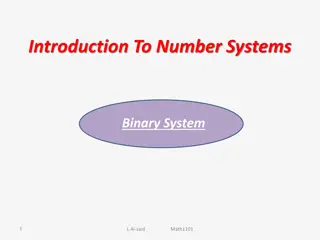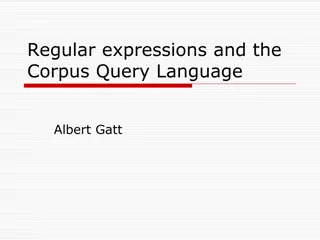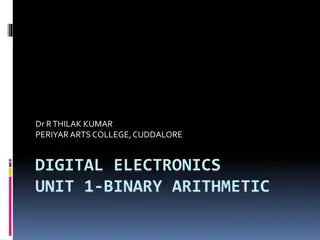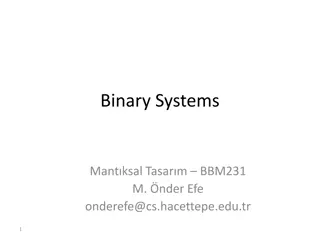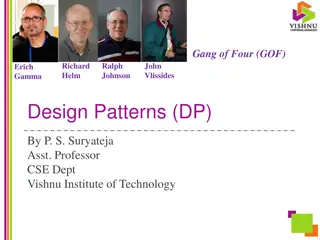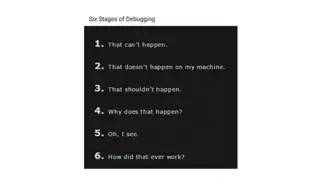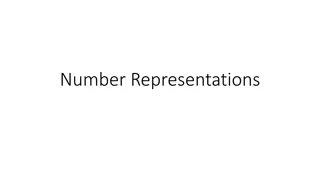Regular Expressions for Language Patterns and Binary Numbers
Regular expressions play a crucial role in specifying patterns of strings with individual meanings. This content explores the use of regular expressions in defining tokens like keywords, identifiers, constants, and operators in programming languages. It delves into constructing regular expressions for different language patterns and binary numbers, showcasing exercises and solutions for creating expressions that represent specific linguistic structures. The provided slides and explanations offer a comprehensive understanding of how regular expressions are used to define languages and patterns through concise string representations.
Download Presentation

Please find below an Image/Link to download the presentation.
The content on the website is provided AS IS for your information and personal use only. It may not be sold, licensed, or shared on other websites without obtaining consent from the author.If you encounter any issues during the download, it is possible that the publisher has removed the file from their server.
You are allowed to download the files provided on this website for personal or commercial use, subject to the condition that they are used lawfully. All files are the property of their respective owners.
The content on the website is provided AS IS for your information and personal use only. It may not be sold, licensed, or shared on other websites without obtaining consent from the author.
E N D
Presentation Transcript
CS314 Section 5 Recitation 2 Long Zhao (lz311@rutgers.edu) Regular Expressions DFA, NFA Homework 1 Slides available at http://www.ilab.rutgers.edu/~lz311/
Regular expressions Token: shortest string of characters with individual meaning. E.g. keywords, identifier, constant, operator, Language has few to hundreds of tokens. C language: keyword (int, float, return), identifier (var1, func), constant (0x01, 0.01), operator (+, -, ) Regular expression: a pattern used to specify a set of strings required for a particular purpose.
Regular expressions (From Scott book) A regular expression is one of 1. A character 2. The empty string, denoted 3. Two regular expressions next to each other, meaning any string generated by the first one followed by (concatenated with) any string generated by the second one 4. Two regular expressions separated by a vertical bar ( | ), meaning any string generated by the first one or any string generated by the second one 5. A regular expression followed by a Kleene star, meaning the concatenation of zero or more strings generated by the expression in front of the star
Regex exercises Find regex representing the language Language Regex {0} {0,1} {0,01} {0, }{001} {1}*{10} {10,11,1100}*
Regex exercises Find regex representing the language Language Regex {0} 0 {0,1} 0|1 {0,01} 0|01 {0, }{001} (0| )001 {1}*{10} 1*10 {10,11,1100}* (10|11|1100)*
Regex exercises 1. Construct a regular expression for binary numbers of length two. 2. Construct a regular expression for binary numbers with even length. 3. Find regular expressions over {0, 1} that determine the language which consists of all strings with even number of 1s.
Regex exercises 1. Construct a regular expression for binary numbers of length two. (0|1)(0|1) or (00|01|10|11)
Regex exercises 2. Construct a regular expression for binary numbers with even length. ((0|1)(0|1))* or (00|01|10|11) *
Regex exercises What would be the regular expression corresponding to the language which consists of all strings of 0s and 1s that have odd length?
Regex exercises What would be the regular expression corresponding to the language which consists of all strings of 0s and 1s that have odd length? Based on the previous example, we can add only 1 digit to the front or the end of the string. Thus, the regular expression can be (0|1)(00|01|10|11)* or (00|01|10|11)*(0|1).
Regex exercises 3. Find regular expressions over {0, 1} that determine the language which consists of all strings with even number of 1s. (0*10*10*)*
Regex exercises Find regular expressions over {0, 1} that determine the language which consists of all strings with odd number of 0s.
Regex exercises Find regular expressions over {0, 1} that determine the language which consists of all strings with odd number of 0s. (1*01*)(1*01*01*)*
Regex exercises 4. Construct a regular expression for integers (e.g., 0, 42, -137, etc.). 5. Construct a regular expression for floating point numbers that don t use scientific notation (e.g., 3.5, 0.2, -47.3). 6. Construct a regular expression for all strings of a s that have at least 3 a s. Is there more than one way to write this?
Regex exercises 4. Construct a regular expression for integers (e.g., 0, 42, -137, etc.). 0|(-| )(1-9)(0-9)*
Regex exercises 5. Construct a regular expression for floating point numbers that don t use scientific notation (e.g., 3.5, 0.2, -47.3). (-| )0|(1-9)(0-9)*.(0-9)+ (-0.0 is allowed in this regex)
Regex exercises 6. Construct a regular expression for all strings of a s that have at least 3 a s. Is there more than one way to write this? (a*)aaa (a+)aa
Finite-State Automaton S1 0 0 S0 S3 1 1 S2
Finite-State Automaton A Finite-State Automaton is a quadruple: <S, s, F, T> S is a set of states, e.g., {S0,S1,S2,S3} s is the start state, e.g., S0 F is a set of final states, e.g., {S3} T is a set of labeled transitions, of the form (state, input) => state
DFA & NFA DFA - Determistic Finite Automaton: At most one transition for a state and an input symbol. (Recognizers should be a DFA.) NFA - Nondeterministic Finite Automaton: More than one transition possible for a state and an input symbol.
Constructing a DFA from a RE Regular Expression (RE) NFA with moves NFA with moves to NFA NFA DFA
NFA with moves (5 rules) A A A B AB
NFA with moves (5 rules) A A|B B A A*
NFA with moves (Examples) (A|B)C A C B
NFA with moves (Examples) A|BC A B C
NFA with moves (Examples) ((A|B)C)* A C B
DFA (Examples) A A A B AB
DFA (Examples) A A|B B A A+ A* A A
